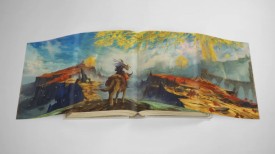New Book Examines the Lesser-Known Works and Artistic Journey of M.C. Escher
In the realm of art, the works of M.C. Escher stand out with his non-realistic illustrations, such as stylized staircases and optical illusions. These surreal pieces of work will hold a remarkable impact along with that of Monet and Van Gogh.
"Escher," a new book edited by Mark Veldhuysen and Federico Giudiceandrea, is a visual exploration taking readers to lesser-known works of Escher. The book also shows interpretations and a unique insight into the artist's mysterious world.
Mind-Bending Artistry and Enduring Influence
Escher, also known as Maurits Cornelis Escher, is recognized for his mind-boggling prints and drawings investigating unparalleled forms, out-of-plane figures, and transformations. Escher's art generally stimulates the viewer's perception and plays with perspectives.
Escher's renowned works have had a lasting impact. It shaped various fields, such as mathematics, art, and popular culture. Following his death on March 27, 1972, Escher left behind an impressive artistic legacy. His achievements inspire artists and enthusiasts, driving ongoing studies of three-dimensional models based on his woodcut prints and drawings. His work also sparks tessellation contests and related projects worldwide, showcasing the enduring impact of his contributions to the art world.
Escher's Journey and Italy's Transformative Influence
In addition to displaying some of his most notable pieces, this book draws from an extensive and unknown body of his work to give an exceptional view of his artistry. The book also enables the reader to discover his childhood, education, and the emergence of his aesthetic perspective. It mainly focuses on the years following his formal education, when Escher's fascination with geometries, puzzle art, tessellation, and paradox took root, influenced significantly by his experiences in Italy during the 1920s.
READ ALSO: Thousands of Classic Films, Books, and Illustrations Enter the Public Domain
Escher's first encounter with Italy occurred in 1921 when, at 22, he visited the Mediterranean coast with his parents. His subsequent grand tour in Tuscany, including a return to Italy and a settling in Rome in 1924, was pivotal in shaping his artistic identity. The book highlights Escher's love for the Italian landscape and how exposure to modern art during the Venice Biennale impacted his artistic journey.
During his early years in Italy, Escher focused on naturalistic illustration, creating studies of cityscapes and the Italian countryside. These studies laid the groundwork for the intricate prints he later became renowned, for which he combined various perspectival views to craft enigmatic compositions.
Escher's fascination with spheres, evident in his self-portraits, may have been inspired by the elaborate cathedral ceilings of Vatican City. The book features iconic works like the Circle Limit series and Nocturnal Rome, a collection of woodcuts created during his nighttime wanderings through the city. Escher's profound connection with Rome is revealed in a letter expressing his love for sketching the city at night, appreciating its architecture in the moonlight.
"Escher" offers a window into the artist's world, providing greater insight into his creative process and displaying lesser-known treasures from his tremendous portfolio. Although the book covers Escher's whole career, it specifically emphasizes Italy's effect on his art.
Recently, Escher's "Tower of Babel," showcasing a dizzying perspective of the famous structure, became part of the public domain. The artwork joins alongside works of André Breton, Francis Picabia, Georgia O'Keeffe, and more.
RELATED ARTICLE: Bianca Bosker's New Book Shares Her Experience in Unveiling the Contemporary Art World's Mysteries
© 2023 Books & Review All rights reserved.
Popular Now
1
Books to Read After 'Fourth Wing': Top Picks for Fantasy and Romantasy Fans

2
‘The Secret Public’ by Jon Savage Book Review: An Insightful Look Into the LGBTQ Influence

3
Stephanie Regalado's 'If They Only Knew' Column Is Now A Book, Unleashing 60 Anonymous True Stories to Empower Women

4
'No Wire Hangers' Scene That Almost Did Not Happen: New Book Reveals Faye Dunaway's Struggles

5
Rare First Edition of Aphra Behn's Novel 'Oroonoko' Discovered in Kent: A Historic Literary Find

Latest Stories
Book Reviews
‘The Secret Public’ by Jon Savage Book Review: An Insightful Look Into the LGBTQ Influence

Book News
Stephanie Regalado's 'If They Only Knew' Column Is Now A Book, Unleashing 60 Anonymous True Stories to Empower Women

Book News
'No Wire Hangers' Scene That Almost Did Not Happen: New Book Reveals Faye Dunaway's Struggles

Book Reviews
‘The Perfect Couple’ by Elin Hilderbrand Book Review: A Captivating Summer Mystery

Book News
New Book ‘The Franchise’ Reveals Penguins President Kyle Dubas’ ‘Biggest Mistake’ as Maple Leafs GM











